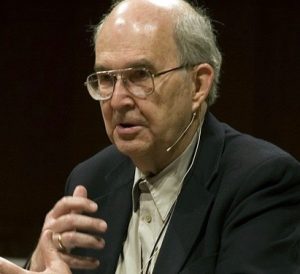Most of us grew up with standard Christmas images—baby in a stable, surrounded by cows, sheep, shepherds, and wise men. And a star  overhead.
overhead.
But what if some of those images are wrong? What if centuries of birth-event “interpretation” leaves us with a false picture
Fasten your seatbelts—here comes Kenneth Bailey!
Joseph’s genealogy links him directly with King David, who had been born in Bethlehem. According to Middle Eastern culture, anyone—with or without those credentials—would have been welcomed warmly, and space would have been found for him and his pregnant wife. Mary’s cousin Elizabeth also lived in the area and would gladly have taken them in. But “no room in the inn” plugs in our modern, motel mentality. Sorry. Go away!
Many houses in that era had guest rooms, often on the roof. In that particular home, the guest space was full up. Well, never mind. Welcome to our living quarters. Picture the layout:
 Houses of commoners had only one room for eating and sleeping, with a lower level for their animals. All one house. The upper-level floor had holes or depressions at one end that served as mangers for the lower-level animals. Doesn’t everyone have mangers in their living room? The perfect place to lay a swaddled, newborn infant.
Houses of commoners had only one room for eating and sleeping, with a lower level for their animals. All one house. The upper-level floor had holes or depressions at one end that served as mangers for the lower-level animals. Doesn’t everyone have mangers in their living room? The perfect place to lay a swaddled, newborn infant.
Was Jesus born the night of their arrival or sometime afterwards? Luke 2:6—”While they were there, the days of her pregnancy were fulfilled.” And did Joseph himself serve as midwife? Unthinkable, given the cultural importance of hospitality! The men, including the daddy, would have been shoved out the door, and women would have cared for Mary.
Does this view of Jesus’ birth rip holes in your heart? Have we become so caught up in our familiar, comfortable “Christmas” that we can’t see past the accretions that blind us to what life was like in Jesus’ day?

I
Kenneth Bailey spent most of his life in the Middle East and experienced firsthand the hospitality of that culture. He knows Scripture and sees clearly how the two mesh. If you’d like to get his take on this, here is a longish video: https://video.search.yahoo.com/yhs/search?fr=yhst-goodsearch-goodsearch_yhs&hsimp=yhs-goodsearch_yhs&hspart=goodsearch&p=kenneth+e+bailey#id=2&vid=eadaf2e8fc614a9882fdff1a5ed09369&action=click
Stay tuned for Part 2—the shepherds.
Please leave a comment, or email me at egus@me.com

I love Kenneth Bailys book
Jesus Through Middle Eastern Eyes. I believe he is right on!
A Fellow Bailey Follower! : ). The last time I tried this—years ago—I got a lot of negatives. We’ll see how many I get this time around.
Thanks much, Susan!
Susan, I found your series for girls online. How may I contact you about that for my 13 yr old granddaughter?
I’ve never heard of Kenneth before, but what he says seems quite possible to me and doesn’t compromise my faith. Thanks, Ellie.
Listened to Kenneth Bailey’s you-tube talk and also found it incredibly ” unorthodox ” in it’s orthodoxy….I loved the way he explained the “Layers of Mythology” we have all accepted as integral to the Christmas story. I am curious to look over the Christmas Carols now, and see what lies within!
Thank you Ellie, for sharing this.
Yes, unorthodox is a good word for Bailey. But he does look CLOSELY at Scripture, and that’s as orthodox as you can get. Thanks, Dotty!
Hi Ellie, I love learning real context – time, place, customs, history… For me, the historical novel writers Bodie and Brock Thoene are a great resource because they research historical context so carefully. In one of their series, Jesus is born during lambing season in the very place the chosen lambs are birthed for use in Temple worship. Then the little family is taken in by the woman who assisted in Jesus’ birth.
I’ll be watching Mr. Bailey’s video. Thank you!
Thanks, Marcia. I’m so glad to hear that the Thoenes picked up on having a woman assist with the birth. The actuality was probably a lot less bleak than our cultural assumptions depict. Thank you for reading and commenting, and I know you’ll like the video.
Christ’s birth, just as His life and death were anything but “traditional”. Nothing He did followed the norms of the day. His first recognition was by a child still in their mother’s womb. He stood in the temples and taught without being educated by the system. He dined and visited with those who tradition forbid. Christ died on a cross, but rose again to life. Scripture tells us that Joseph would not have taken her to family of friends to stay due to being unwed and with child.Sadly, in my opinion, Dr. Bailey seems more interested in trying to “Normalize” Christ than accept Him as the supernatural being He is. I for one will chose to continue to accept the divinely inspired biblical record Luke plainly tells us in Chapter 2, verse 7…Because there was no room fo Him, just as so many people now have “no room for Him in their lives.” of Jo
Thank you, Barry, for taking the other side of this discussion. You are so right in Jesus being the “odd” person, all through his life. Nothing he did was “normal,” apart from his being fully human. I’m not arguing that Bailey’s take on this is the absolute truth, only that it COULD have happened this way, given the cultural norms of the day. Thanks so much for stepping in with a different viewpoint.
I’m sticking with your pov. It’s Biblically sound, doctrinally secure. I totally agree!
Well, the account in the Bible states very clearly (NIV) “She wrapped him in cloths and placed him in a manger, because there was no guest room available for them.”
NO GUEST ROOM AVAILABLE. This doesn’t mean the town wasn’t normally hospitable or that she and Joseph would have been completely alone in a stable, but that there was no guest room available clearly isn’t up for negotiation.
I haven’t cross-checked this with the Greek or other translations, but there’s a REASON we got these “comfortable” images, as you put it.
And an early Merry Christmas to you, by the way, Ellie!
Thank you, Linore, for your input in this INTERESTING discussion. None of us–including Bailey–really know or can say that he is right or wrong. I’ve looked at two or three translations, including the Orthodox Jewish Bible, and some indicate that there was no PLACE or SPACE in the inn or guest room. Most village houses did have guest rooms, and during this census period, this particular homeowner’s guest room could well have been full up. The real issue may be whether or not Bailey is right about mangers being in the living space. For that, we can only trust–or not trust–his knowledge of Middle East culture. And, of course, the imagery of Christmas takes second place to God–in human flesh–coming to dwell with us in our heart’s guest space.